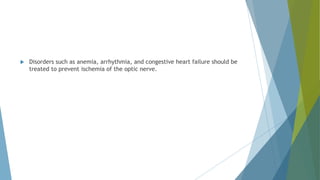Normal tension glaucoma (NTG) is an optic neuropathy characterized by optic nerve damage and visual field loss with intraocular pressure below 21 mmHg. It has distinct risk factors including age, sex, central corneal thickness, myopia, and vascular dysregulation, differing from primary open-angle glaucoma (POAG). Treatment aims to lower IOP by at least 30% to slow disease progression, with a combination of medical therapies commonly employed.

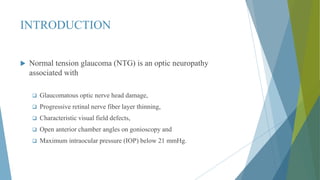



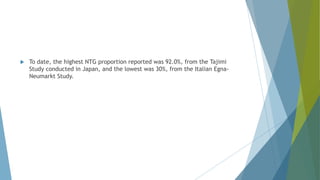

![ IOP-Dependent Mechanisms
Glaucomatous eyes exhibit conjunctival change induced by high IOP –
impression cytology and laser scanning invivo confocal microscopy.
Epithelial microcysts formed – Post Trab, POAG, OHT. [1]
NTG patients shows similar changes, indicating that hyperbaric damage
also plays a role even in eyes within the IOP reference range. [2]
NTG patients have IOP within the reference range but higher than those of
normal subject.
Protective effect of IOP-lowering treatment.
NTG pressures are not as high as POAG ones, IOP still plays an important
role in the pathogenesis of NTG.
1 Messmer EM, Zapp DM, Mackert MJ, et al. In vivo confocal microscopy of filtering blebs after
trabeculectomy. Arch Ophthalmol. 2006;124:1095–1103.
2. Ciancaglini M, Carpineto P, Agnifili L, et al. Conjunctival modifications in ocular hypertension and
primary open angle glaucoma: an in vivo confocal microscopy study. Invest Ophthalmol Vis Sci. 2008;49:
3042–3048.](https://image.slidesharecdn.com/ntg-160811133803/85/Normal-Tension-Glaucoma-8-320.jpg)


![ Blood Pressure
Increased or decreased blood pressure ????? Unsolved. [1]
Diastolic perfusion pressure – (diastolic blood pressure – IOP),
Normal – 50-70 mmHg.
Excessive blood pressure lowering with antihypertensive medication or nocturnal
hypotension - decreased ocular perfusion pressure - insufficient oxygen and
nutritional support to the optic nerve head and subsequent ischemic injury – NTG
1. Zhao D, Cho J, Kim MH, et al. The association of blood pressure and primary open-angle glaucoma: a
meta-analysis. Am J Ophthalmol. 2014; 158:615.e9–627](https://image.slidesharecdn.com/ntg-160811133803/85/Normal-Tension-Glaucoma-11-320.jpg)
![ Ocular Perfusion Pressure
Defined as two-thirds of the mean blood pressure – IOP.
Decreased ocular perfusion pressure in glaucomatous eyes is important
pathomechanism, particularly in NTG eyes.
In a study by Plange et al Prolonged arteriovenous passage time, reflecting
impaired autoregulation was found in NTG. [1]
Correlating with low mean arterial blood pressure and low ocular perfusion
pressure.
Large fluctuation of ocular perfusion pressure is a risk factor for NTG
development.
1. Okumura Y, Yuki K, Tsubota K. Low diastolic blood pressure is associated with the progression of
normal-tension glaucoma. Ophthalmologica. 2012;228:36–41.](https://image.slidesharecdn.com/ntg-160811133803/85/Normal-Tension-Glaucoma-12-320.jpg)



![ Autoimmunity
Increased titres of serum antibodies against retinal or optic nerve
proteins.
Indicating that RGC degeneration can be accelerated by an imbalance
of immune regulation between the proapoptotic and antiapoptotic
pathways. [1]
Patients with NTG also showed increased antiphosphatidylserine
antibodies compared with POAG patients and control subjects [2]
Other hypotheses are - release of proinflammatory and vasoactive
substances, platelet activation and aggregation, production of
reactive oxygen species, or antibodies against H. pylori cross-reacting
with RGC, thus inducing their degeneration.[3]
1. Mastropasqua R, Fasanella V, Agnifili L, et al. Advance in the pathogenesis and treatment of
normal-tension glaucoma. Prog Brain Res. 2015;221:213–232
2. Kremmer S, Kreuzfelder E, Klein R, et al. Antiphosphatidylserine antibodies are elevated in
normal tension glaucoma. Clin Exp Immunol. 2001;125:211–215.
3. Kim JM, KimSH, ParkKH, et al. Investigation of the association between Helicobacter pylori
infection and normal tension glaucoma. Invest Ophthalmol Vis Sci. 2011;52:665–668.](https://image.slidesharecdn.com/ntg-160811133803/85/Normal-Tension-Glaucoma-16-320.jpg)
![ Genetic/Hereditary Factors
Number of genes –
Optineurin (OPTN),
Myocilin (MYOC), [1]
WD repeat-containing protein 36 (WDR36),
optic atrophy 1 (OPA), [2]
Toll-like receptor4 (TLR4) genes] [3]
Other Caueses
Hypercoagulability and increased blood viscosity
Diffuse cerebral ischemia
1. Stone EM, Fingert JH, Wallace LM, et al: Identification of a gene that causes primary open angle
glaucoma. Science 1997; 275:668–670.
2. Mabuchi F, Tang S, Kashiwagi K, Yamagata Z, Iijima H, Tsukahara S. The OPA1 gene polymorphism is
associated with normal tension and high tension glaucoma. Am J Ophthalmol. 2007;143(1):125–130.
3. Shibuya et al. Association of Toll-like Receptor 4 Gene Polymorphisms with Normal Tension
Glaucoma. Invest. Ophthalmol. Vis. Sci. 2008;49(10):4453-4457.](https://image.slidesharecdn.com/ntg-160811133803/85/Normal-Tension-Glaucoma-17-320.jpg)






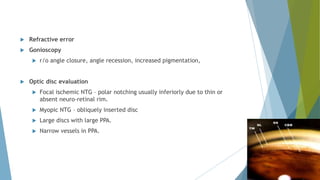

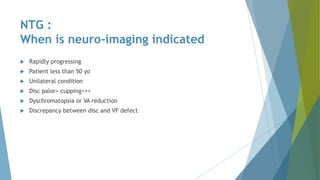
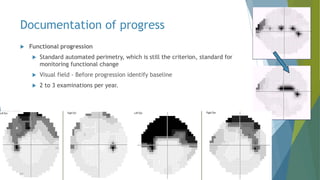








![ MEDICAL TREATMENT
Prostaglandin analogues. [1]
Current gold standard for medical glaucoma therapy.
Single most effective agent in reducing IOP with adequate diurnal control.
Latanoprost , bimatoprost and travoprost.
Reduction in 20% of mean IOP.
1. Gulati V, Fan S, Zhao M, Maslonka MA, Gangahar C, Toris CB. Diurnal and nocturnal variations
in aqueous humor dynamics of patients with ocular hypertension undergoing medical therapy.
Arch Ophthalmol. 2012;130:677–84.](https://image.slidesharecdn.com/ntg-160811133803/85/Normal-Tension-Glaucoma-36-320.jpg)
![ Beta blockers –
Beta blockers and adrenergic drugs (dipivefrine) should better be avoided.
Probability of nocturnal systemic hypotension and optic nerve
hypoperfusion. [1}
Betaxolol eye drops have a beneficial effect on optic nerve blood flow in
addition to IOP reduction. [2]
1. Hayreh SS, Podhajsky P, Zimmerman MB. Betablocker eyedrops and nocturnal arterial hypotension.
Am J Ophthalmol. 1999;128:301–19.
2. Kanski JJ, Bowling B, Nischal K, Pearson R. Clinical Ophthalmology: A Systematic Approach. 7th ed.
Edinburgh: Elsevier Saunders; 2011. p. 346-348.](https://image.slidesharecdn.com/ntg-160811133803/85/Normal-Tension-Glaucoma-37-320.jpg)
![ Alfa agonist
Brimonidine treated patients were less likely to have visual field
progression compared to timolol treated patients (9.1 and 39.2%,
respectively) despite similar reductions in IOP by both drugs. [1]
Retinal vascular autoregulation in NTG patients.
Alpha agonists, specifically brimonidine, have been shown to be
neuroprotective in animal models of optic nerve and retinal injury. [2]
1. Krupin T, Liebmann JM, Greenfield DS, Ritch R, Gardiner S. LowPressure Glaucoma Study Group. A
randomized trial of brimonidine versus timolol in preserving visual function: Results from the
LowPressure Glaucoma Treatment Study. Am J Ophthalmol. 2011;151:671–81.
2. Saylor M, McLoon HK, Harrison AR, Lee MS. Experimental and clinical evidence for brimonidine as
an optic nerve and retinal neuroprotective agent: An evidencebased review. Arch Ophthalmol.
2009;127:402–6.](https://image.slidesharecdn.com/ntg-160811133803/85/Normal-Tension-Glaucoma-38-320.jpg)
![ Carbonic anhydrase inhibitors
Both, acetazolamide and Dorzolamide are useful as adjunctive.
May provide better diurnal IOP control than timolol
Dorzolamide-timolol fixed combination (DTFC) is a safe and effective
IOP-lowering agent in patients with NTG. [1]
1. Kim TW, Kim M, Lee EJ, Jeoung JW, Park KH. Intraocular pressure-lowering efficacy of
dorzolamide/timolol fixed combination in normal-tension glaucoma. J Glaucoma
2014;23:329-332.](https://image.slidesharecdn.com/ntg-160811133803/85/Normal-Tension-Glaucoma-39-320.jpg)
![ LASERS
Because NTG patients have baseline IOPs in the statistically normal range,
it is often difficult to achieve IOPs in the single digits with medications
alone.
Argon laser trabeculoplasty
May provide better diurnal control than some of the commonly used
ocular hypotensive agents. [1]
Bulk of the evidence suggests that argon laser trabeculoplasty is of
limited benefit in normal-tension glaucoma.
Worth trying in patients who are reluctant to undergo, or are high-risk
candidates for surgical intervention. [2]
Selective laser trabaculoplasty
1. Sharpe ED, Simmons RJ: Argon laser trabeculoplasty as a means of decreasing intraocular pressure
from ‘normal’ levels in glaucomatous eyes, Am J Ophthalmol 99:704, 1985.
2. Schulzer M: The Normal-Tension Glaucoma Study Group: intraocular pressure reduction in normal-
tension glaucoma patients, Ophthalmology 99:1468, 1992.](https://image.slidesharecdn.com/ntg-160811133803/85/Normal-Tension-Glaucoma-40-320.jpg)
![ GLAUCOMA FILTERING SURGERY
Trabaculectomy
INDICATION - No adequate control with medical therapy or laser
trabeculoplasty.
The most effective method of achieving low IOPs.
It blunts diurnal and nocturnal IOP fluctuations even in the setting of postural
changes. [1]
1. Klink T, Praetorius S, Leippi S, Klink J, Grehn FJ. Diurnal and nocturnal intraocular
pressure fluctuations after trabeculectomy. Ophthalmologica. 2012;227:160–5.](https://image.slidesharecdn.com/ntg-160811133803/85/Normal-Tension-Glaucoma-41-320.jpg)
![ AQUEOUS SHUNTS
Lower failure rate and fewer complications than trabeculectomy
Trabeculectomy have a significantly higher 5 year cumulative probability of success
[1]
Trabeculectomy is likely a more suitable surgical option than glaucoma drainage
devices in NTG [2]
1. Gedde SJ, Herndon LW, Brandt JD, Budenz DL, Feuer WJ, Schiffman JC. Tube versus
Trabeculectomy Study Group. Postoperative complications in the Tube Versus Trabeculectomy
Study (TVT) during five years of followup. Am J Ophthalmol. 2012;153:804–14.
2. Tran DH, Souza C, Ang MJ, Loman J, Law SK, Coleman AL, et al. Comparison of longterm
surgical success of Ahmed Valve implant versus trabeculectomy in openangle glaucoma. Br J
Ophthalmol. 2009;93:1504–9.](https://image.slidesharecdn.com/ntg-160811133803/85/Normal-Tension-Glaucoma-42-320.jpg)
![ NONPENETRATING GLAUCOMA SURGERY
Nonpenetrating deep sclerectomy
Less complications compared with more invasive procedures.
Lachkar et al., showed that nonpenetrating deep sclerectomy was
associated with an IOP reduction of 33.73 ± 20.9% after 6 years with few
complications. [1]
Results are comparable with trab with less complications than trab. [2]
1. Lachkar Y, Neverauskiene J, JeanteurLunel MN, Gracies H, Berkani M, Ecoffet M,
et al. Nonpenetrating deep sclerectomy: A 6year retrospective study. Eur J
Ophthalmol. 2004;14:26–36.
2. Leszczynski R, ForminskaKapuscik M, BubulaStachowicz B, MrukwaKominek E,
Filipek E, Pawlicki K. Nonpenetrating very deep sclerectomy with hyaluronic acid
implant vs trabeculectomy—A 2year followup. Graefes Arch Clin Exp Ophthalmol.
2012;250:1835–41.](https://image.slidesharecdn.com/ntg-160811133803/85/Normal-Tension-Glaucoma-43-320.jpg)
![Non IOP lowering treatment modalities/
Neuroprotection
GLUTAMATE ANTAGONISTS
Glutamate is an excitatory neurotransmitter in the CNS and retina.
Excitotoxic at high extracellular levels.
Glutamate excitotoxicity is associated with retinal ganglion cell death [1]
N-methyl D-aspartate (NMDA), has been proposed as a potential
therapeutic target for neuroprotection in glaucoma [2]
1. Martin KR, LevkovitchVerbin H, Valenta D, Baumrind L, Pease ME, Quigley HA. Retinal glutamate
transporter changes in experimental glaucoma and after optic nerve transection in the rat. Invest
Ophthalmol Vis Sci. 2002;43:2236–43.
2. Guo L, Salt TE, Maass A, Luong V, Moss SE, Fitzke FW, et al. Assessment of neuroprotective effects of
glutamate modulation on glaucomarelated retinal ganglion cell apoptosis in vivo. Invest Ophthalmol Vis
Sci. 2006;47:626–33.](https://image.slidesharecdn.com/ntg-160811133803/85/Normal-Tension-Glaucoma-44-320.jpg)
![ UNOPROSTONE
It is prostanoid and synthetic docosanoid.
Increases aqueous outflow via the trabecular meshwork
Approved by the US-FDA for IOP reduction in OAG and OHT.
May prolong neuronal survival independent of its ability to lower IOP,
due to improved ocular blood flow via antagonism of ET1. [1]
1. Munemasa Y, Kitaoka Y, Hayashi Y, Takeda H, Fujino H, OhtaniKaneko R, et al. Effects of
unoprostone on phosphorylated extracellular signalregulated kinase expression in endothelin
1induced retinal and optic nerve damage. Vis Neurosci. 2008;25:197–208.](https://image.slidesharecdn.com/ntg-160811133803/85/Normal-Tension-Glaucoma-45-320.jpg)
![ CALCIUM CHANNEL BLOCKERS (CCBS)
Centrally acting CCBs, such as nimodipine and nifedipine, improve ocular
blood flow and color sensitivity in glaucoma patients. [1]
Lowdose nifedipine has also been shown to reverse ET1 induced ocular
hemodynamic effects. [2]
1 Luksch A, Rainer G, Koyuncu D, Ehrlich P, Maca T, Gschwandtner ME, et al. Effect of nimodipine on
ocular blood flow and colour contrast sensitivity in patients with normal tension glaucoma. Br J
Ophthalmol. 2005;89:221–5.
2. Strenn K, Matulla B, Wolzt M, Findl O, Bekes MC, Lamsfuss U, et al. Reversal of endothelin1 induced
ocular hemodynamic effects by lowdose nifedipine in humans. Clin Pharmacol Ther. 1998;63:54–63.](https://image.slidesharecdn.com/ntg-160811133803/85/Normal-Tension-Glaucoma-46-320.jpg)
![ 3- HYDROXYL 3-METHYL GLUTARYL COENZYME A (HMG CO-A) REDUCTASE
INHIBITORS
Possess an antiapoptotic and neuroprotective effect suggesting that
longterm use may reduce the risk of glaucoma [1]
GINKGO BILOBA
Indigenous to Korea, Japan and China.
Ginkgo extracts may have antioxidative properties. [2]
Recent study found improved peripapillary blood flow in NTG patients
consuming ginkgo biloba extract when compared to control patients. [3]
1. Owen CG, Carey IM, Shah S, de Wilde S, Wormald R, Whincup PH, et al. Hypotensive
medications, statins and the risk of glaucoma. Invest Ophthalmol Vis Sci. 2010;51:3524–30.
2. Ou HC, Lee WJ, Lee IT, Chiu TH, Tsai KL, Lin CY, et al. Ginkgo biloba extract attenuates
oxLDLinduced oxidative functional damages in endothelial cells. J Appl Physiol. 2009;106:1674–
85.
3. Park JW, Kwon HJ, Chung WS, Kim CY, Seong GJ. Shortterm effects of gingko biloba extract on
peripapillary retinal blood flow in normal tension glaucoma. Korean J Ophthalmol. 2011;25:323–
8.](https://image.slidesharecdn.com/ntg-160811133803/85/Normal-Tension-Glaucoma-47-320.jpg)
